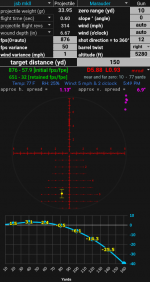Not sure when or even if I'll make my new ballistic solver public, as most people already have their preference, but wanted to show off the work I put in this last week developing one that uses G1, GA, GA2, RA4, SLG0, SLG1, WC0, G7, and some other drag references, while also receiving input on what could or should be added if its not present already. Its a common 3DOF(+) ballistic solver using Euler's method to calculate drag. Nothing too fancy, was/is mostly a challenge to myself and to help myself understand some of the dynamics going on externally with projectiles during flight, all this and I have barely scratched the surface. The math involved for advanced ballistics is...certainly beyond me...but hey, don't let that set you back, I certainly didn't let it to me.
Below are a few screenshots, left side shows no effects added, while the right side shows all effects added, Spin drift, Magnus effect, Earth based effects which include Coriolis and Eotvos effect, and even the wind being included in zero, a feature I figured would hurt to add that I don't see currently in ballistic solvers. These effects are near meaningless under 200 yards, but really present themselves, more-so with airguns, once pushed beyond.
No added effects vs added effects


Spin drift, Earth based and Magnus effects=.09 / .32 mil at 150 yards = .5" and 1.75" difference, while not a lot, it grows rather quickly as you increase range, which airgunners are frequently doing as technology evolves. .08 of the .32 was the wind being zeroed, still 1.3" with that effect taken out.
The other cool feature is visually showing the vertical stringing. The FPS variance above is 50, and you can see on the reticle, horizontal lines that show where your high and low shots could wander to assuming your fps input used is in the middle. At 50 fps spread you could see upwards of 7" of vertical stringing in the above setup. 50 fps spread was used to show the extreme, as no one in their right mind will shoot 150 yards with a gun that has 50 fps spread, at least not out of enjoyment.
VS 20 fps spread which is calculated to cause roughly 2.6" vertical stringing. (Not shown, 5 fps is .6" vertical spread, at this distance with this setup, and 10 fps is 1.3")


Another neat feature is automatically updating weather that effects your shot. Each component from Temp, humidity, wind speed and wind direction can be set to auto or inputted manually. Its wild to see the effects here in Colorado as the temperature goes from 40F in the morning to 90F in the afternoon. Quite the shift in POA required.
Here is 40F vs 90F:


.52 mil + .23 mil which is quite a shift, and that assumes your gun isn't shooting at a greatly reduced fps in the cold, which it likely is, which would add even more drop.
If you have ideas / features that should be included, feel free to chime in! Happy shooting.
-Matt
Below are a few screenshots, left side shows no effects added, while the right side shows all effects added, Spin drift, Magnus effect, Earth based effects which include Coriolis and Eotvos effect, and even the wind being included in zero, a feature I figured would hurt to add that I don't see currently in ballistic solvers. These effects are near meaningless under 200 yards, but really present themselves, more-so with airguns, once pushed beyond.
No added effects vs added effects
Spin drift, Earth based and Magnus effects=.09 / .32 mil at 150 yards = .5" and 1.75" difference, while not a lot, it grows rather quickly as you increase range, which airgunners are frequently doing as technology evolves. .08 of the .32 was the wind being zeroed, still 1.3" with that effect taken out.
The other cool feature is visually showing the vertical stringing. The FPS variance above is 50, and you can see on the reticle, horizontal lines that show where your high and low shots could wander to assuming your fps input used is in the middle. At 50 fps spread you could see upwards of 7" of vertical stringing in the above setup. 50 fps spread was used to show the extreme, as no one in their right mind will shoot 150 yards with a gun that has 50 fps spread, at least not out of enjoyment.
VS 20 fps spread which is calculated to cause roughly 2.6" vertical stringing. (Not shown, 5 fps is .6" vertical spread, at this distance with this setup, and 10 fps is 1.3")
Another neat feature is automatically updating weather that effects your shot. Each component from Temp, humidity, wind speed and wind direction can be set to auto or inputted manually. Its wild to see the effects here in Colorado as the temperature goes from 40F in the morning to 90F in the afternoon. Quite the shift in POA required.
Here is 40F vs 90F:
.52 mil + .23 mil which is quite a shift, and that assumes your gun isn't shooting at a greatly reduced fps in the cold, which it likely is, which would add even more drop.
If you have ideas / features that should be included, feel free to chime in! Happy shooting.
-Matt

